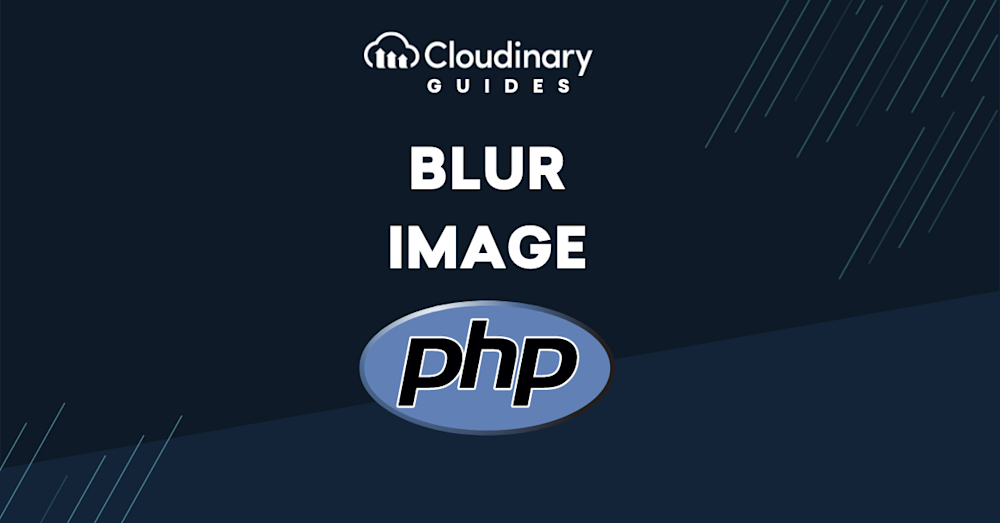In an era where swift website performance is crucial, optimizing images through blurring emerges as a key strategy for web developers. Why blur images? This technique enhances the aesthetic appeal of websites and significantly reduces file sizes, boosting website speed and performance. Moreover, blurring serves as an effective strategy for focusing user attention and creating engaging placeholders for lazily loaded content.
PHP’s flexibility makes it an ideal tool for implementing such optimizations, offering developers a powerful means to improve website performance while maintaining visual quality. Whether your goal is to boost your site’s speed, refine its design, or optimize media content, mastering image blurring with PHP can elevate your web development skills and contribute to a more successful digital presence.
In this article:
- Introduction to Blurring Images in PHP
- Applied Usage of Image Blurring
- Common Errors and Exceptions in Image Blurring with PHP
- Other Methods for Image Blurring in PHP
- Insights into Image Sampling and PHP Image Blur
- Extending Image Blurring to Cloudinary
Blurring Images in PHP
Blurring is a visual effect that can add subtle details to your design, improve image focus, and enhance the overall aesthetic of your product. Blurring images in PHP can be done with the help of PHP’s built-in image manipulation features.
One important aspect of PHP image manipulation is the GD Library. It’s an essential tool that allows developers to generate images dynamically. It permits the creation and manipulation of graphics directly through PHP code rather than through other software, making this tool vital in developing PHP image manipulation.
Another tool, the Imagick class, is a core PHP library that enables developers to create, compose, and edit bitmap images using the ImageMagick API. It provides an object-oriented interface and allows manipulation of images in multiple formats, like GIF, JPEG, PNG, PDF, and many others.
Applied Usage of Image Blurring
One of PHP’s many image manipulation functions is Imagick::blurImage. It’s a practical, efficient way to achieve the blurred image effect, and developers worldwide use it.
The Imagick::blurImage function takes two parameters: radius and sigma. Adjusting these parameters lets you control the intensity and extent of the blur effect on your image.
The parameters of Imagick::blurImage, namely radius and sigma, determine how the blurring effect is applied. The radius indicates the area over which the effect is extended, and sigma controls the standard deviation of the Gaussian operator.
blurImage(5, 3); header('Content-type: image/jpeg'); echo $imagick; ?>
This function won’t return any value but will blur the current object’s image. This is crucial for developers to know while they work with the function, helping them have a clear picture of the output.
Common Errors and Exceptions in Image Blurring with PHP
You might run into a few common hiccups. Keep these troubleshooting tips in mind. They are here to help developers see a clear path and feel more prepared while coding for image blurring in PHP.
Some common issues include not specifying a valid file path, forgetting to instantiate the Imagick class, or not using realpath to get an absolute file path. Addressing these common mistakes can help troubleshoot effectively and efficiently.
Other Methods for Image Blurring in PHP
Though Imagick::blurImage is an easy and effective way to blur image in PHP, other methods are also available. Diversifying methods and exploring other built-in functions advance your skills and provide more options when handling different projects or problem-solving.
Imagefilter, another built-in PHP function, allows the application of different filters to your images. It’s another tool to blur an image while having a broader range of filters.
Insights into Image Sampling and PHP Image Blur
Beyond basic image blurring, you can explore advanced image sampling techniques for different texture effects. Mastering these advanced techniques can broaden your abilities and make you a more versatile web developer.
Image sampling involves changing the image resolution or applying effects like blurring to control how an image is displayed. Image sampling can make an image sharper, smoother, or even produce cooler effects.
Strategies for Efficient Image Processing in PHP
Efficient image processing in PHP is achieved through strategic caching, reducing Input/Output (IO) operations, and utilizing optimized built-in libraries like GD or Imagick. These methods significantly boost performance by minimizing server load and speeding up response times. Understanding and adapting to your server’s limitations—such as memory, CPU power, and storage capacity—further enhances efficiency. This approach ensures that your application leverages server resources effectively, maintaining high performance without overburdening the system. Balancing code optimization with server capabilities results in a fast, reliable, and efficient PHP application, offering an improved user experience through quicker and more responsive image processing.
Extending Image Blurring to Cloudinary
While the Imagick class offers robust options for image manipulation directly within PHP, integrating Cloudinary’s cloud-based image management solution can take your image processing capabilities to the next level. Cloudinary simplifies blurring or pixelating faces in images with minimal code, offering a powerful tool for privacy-focused image adjustments.
Blurring Faces with Cloudinary
To blur faces in an image using Cloudinary, you can utilize the blur_faces effect. This method automatically detects faces in your image and applies a blurring effect, ensuring privacy and focusing attention away from individuals. You can customize the blurring intensity by setting the effect parameter (e_blur_faces in URLs) to a value between 1 and 2000, where a higher value results in a more pronounced blur. Let´s see an example:
(new ImageTag('young_couple.jpg'));
Then we add standard blurring:
(new ImageTag('young_couple.jpg'))
->effect(Effect::blur()
->region(
Region::faces())
);
We can customize the blurring with the following code:
new ImageTag('young_couple.jpg'))
->effect(Effect::blur() ->strength(1000) // Customizable blurring
->region(
Region::faces())
);
Pixelating Faces for Privacy
Alternatively, Cloudinary allows for the pixelation of faces within images, offering another layer of privacy. By setting the effect parameter to pixelate_faces, Cloudinary will pixelate detected faces. The size of the pixel squares is customizable, enabling you to control the degree of obfuscation.
Standard pixelation:
(new ImageTag('young_couple.jpg'))
->effect(Effect::pixelate()
->region(Region::faces())
);
Custom pixelation(50):
(new ImageTag('young_couple.jpg'))
->effect(Effect::pixelate()
->squareSize(50) // Larger pixel squares for more pronounced effect
->region(Region::faces())
);
This code snippet pixelates faces with larger pixel squares, ensuring that faces are obscured while the rest of the image remains clear.
Final Thoughts
Using Cloudinary with PHP makes it easy to blur or pixelate faces in images, adding an extra layer of privacy. This method works well alongside PHP’s usual ways of changing images, giving developers many tools to make websites look better and improve how users experience them. Whether it’s for your project or something for a client, Cloudinary’s versatile and robust features can help you get the job done smoothly.
To learn more about what Cloudinary can do, check out the Cloudinary Cookbook. Using PHP’s Imagick class and Cloudinary together, you can take your web projects to the next level, making sites that are good-looking and fun to use and respect user privacy.
Transform and optimize your images and videos effortlessly with Cloudinary’s cloud-based solutions. Sign up for free today!




